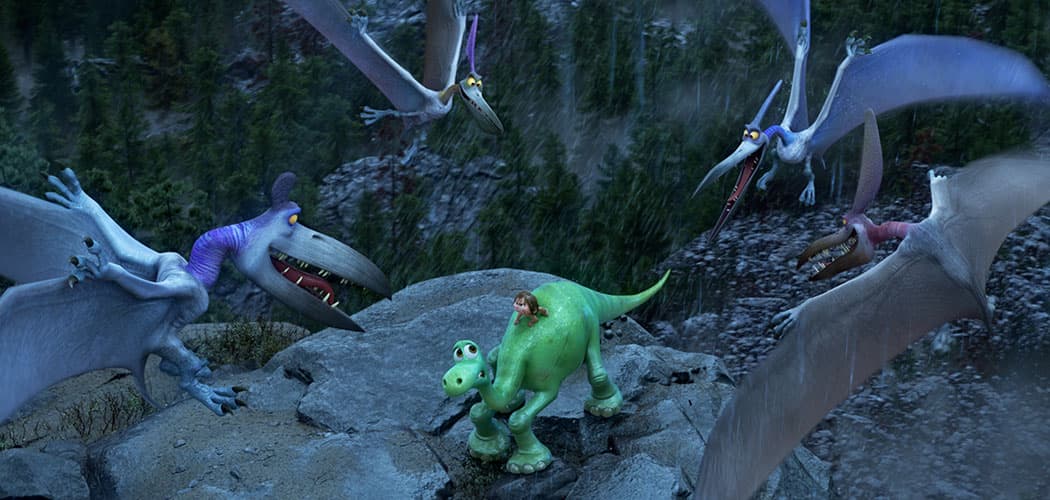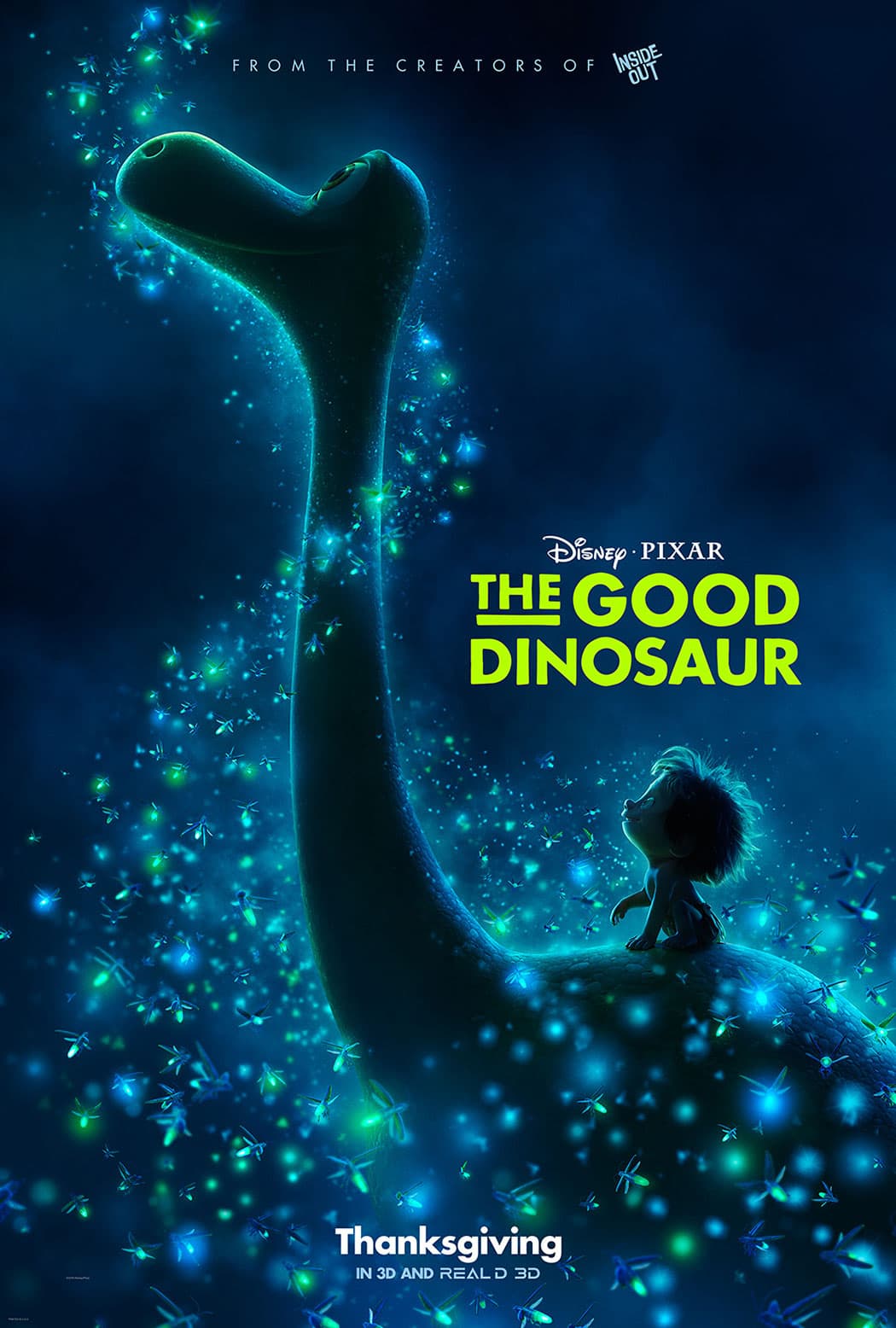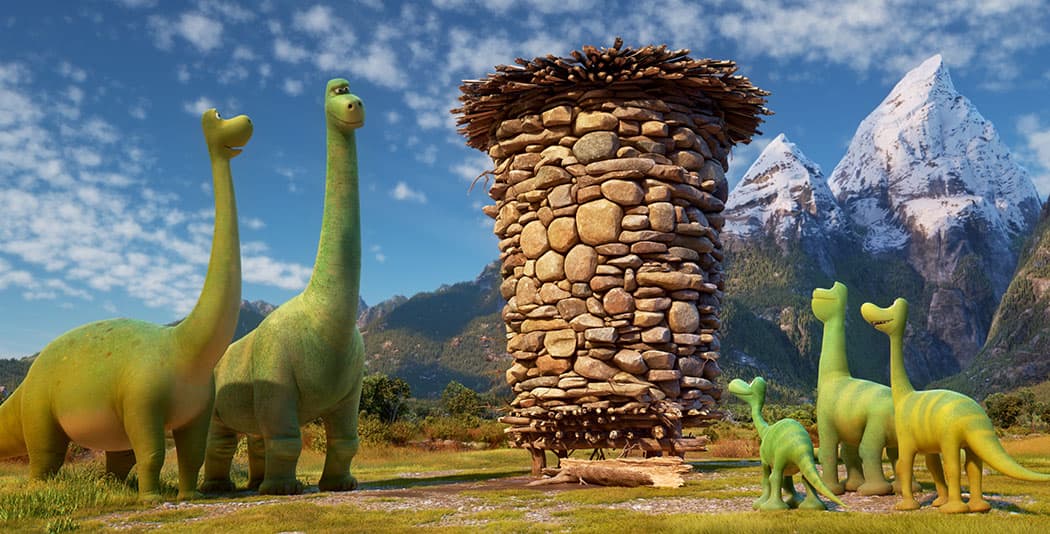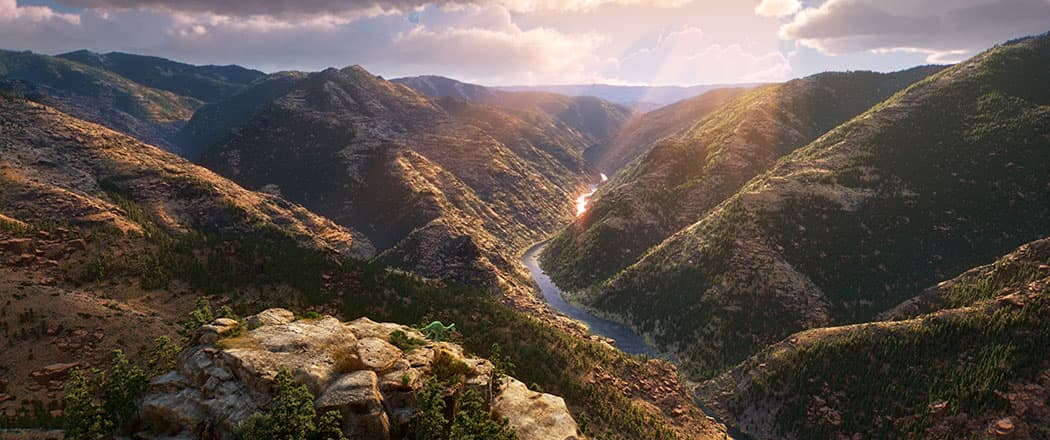Advertisement
In Plucky Adventure ‘The Good Dinosaur,’ Pixar Once Again Tries To Break Our Hearts

In “The Good Dinosaur”—the stellar new Disney-Pixar digitally animated feature film debuting in theaters Nov. 25—the trademark Pixar moment comes when Arlo, a young, green dinosaur rests along a river with his pal “Spot,” who is part boy, part dog, walks on all fours, wears just a diaper of leaves, and speaks only in grunts and growls.

“I miss my family,” says the apatosaurus (a somewhat larger sauropod cousin of the brontosaurus, if you want to get technical about it). He lines up a group of sticks to represent his brother, sister, mother, father, and sketches a circle around them in the sand. “You don’t understand. That’s okay.”
The boy-dog stands up three sticks of his own in the sand and draws a circle around them. Then he knocks two down and buries them. The meaning: His parents have died; he’s an orphan. The dinosaur knocks down his stick representing his own father and buries it. “I miss him,” Arlo says.
In a classic Disney animated film like 1942’s “Bambi,” the young deer tragically loses his mother to a hunter. The famous moment is the boom of the rifle … and Bambi fleeing into the snowy woods alone.
“The Good Dinosaur” has a similar moment, when Arlo loses his dad to a flash flood. The difference is that in Pixar films, the key scene isn’t the moment of tragedy, but sort of behind the beat, when the characters pause to feel it. There on the sandy riverbank, amidst their epic journey, boy-dog and dinosaur are bonded by their broken hearts. Spot howls at the full moon and Arlo echoes him. The view pans up to the starry night sky.
What If?
“The Good Dinosaur,” helmed by first-time Pixar director Peter Sohn, begins with a dazzling question: What if that asteroid that supposedly slammed into the earth 65 million years ago and did in the dinosaurs never crashed here? What if the dinosaurs just looked up to see it flying harmlessly by and shrugged?
It’s a really cool question. The film’s answer? Dinosaurs would have become homesteader farmers and cattle-herding cowboys in what is today’s Wyoming. Literally. Arlo’s family plows fields, plants corn, lives in a log cabin, raises giant chickens (hilarity ensues). In other words, Pixar doesn’t seriously care about the what-if question—it’s just a gag to (1) land dinosaurs in the Hollywood Old West and (2) get your favorite dinosaurs into the same time frame as humans.
Not a bad gimmick, but there’s something a little disappointing when a team as brilliant as Pixar settles for old tropes. But as cockamamie Pixar set-ups go, it’s not nearly as ludicrous as 2006’s “Cars,” Pixar’s genuflection to the NASCAR crowd with a world in which everything is basically the same as ours, except there are no people, just cars, who supposedly built everything, without any sort of hands or claws or nothing. Ultimately the Old West setting of “The Good Dinosaur” feels sort of familiar, comfortable.

Arlo (Raymond Ochoa) is the smallest of three children to a dinosaur pioneer couple who speak in slow Western drawls and spout flinty wisdom. (Let’s agree to call them dinosaurs, but really they’re cute rubber toys blown up to giant scale.) “You’ve got to earn your mark by doing something big, bigger than your self,” Poppa (Jeffrey Wright) says.
Arlo’s siblings quickly make their marks, but Arlo, saddled with caring for the farm’s scary chickens, struggles to pass muster. “Sometimes you got to get through your fear to see the beauty on the other side,” Poppa says.
Poppa tries to buck him up by taking him out for a special evening of watching fireflies dance above a field. Then dad assigns him to trap and club to death whatever varmit is raiding their corn silo. The net catches a snarling man-cub, later dubbed “Spot” (Jack Bright). Arlo lets him get away. Dad is angry and makes him give chase. Together they track it along a river as it begins to rain.
“What if we get lost?” Arlo worries. “As long as you can find the river, you can find the way home,” says Poppa, who realizes that he’s pushing Arlo too hard. Then a flash flood rushes down the river. Poppa throws Arlo to higher ground and safety, but dad gets swept away to his death.
Cut to a rough wooden tombstone on the family’s farm—the sight of which feels unfortunately comical. Now Arlo has to help his widowed Momma keep the farm going. He discovers the boy-dog in the silo again, chases him out (“This is all your fault! My Poppa would still be alive if it weren’t for you!”), stumbles into the river, smashes into a rock, gets knocked unconscious, and wakes up far down stream. Very far down river, it turns out.
A String Of Masterpieces
What is it about Pixar films that we find so entrancing? Something about marvelous technology wedded to solid, old time storytelling. The company has proven itself to be one of the most remarkable collections of creative folks in history. Their run of great films—many of them masterpieces—from 2003 to 2010 was astonishing: “Finding Nemo,” “The Incredibles,” “Cars,” “Ratatouille,” “Up,” “Toy Story 3.”
But Pixar has been in something of a slump since then, beginning with “Cars 2” in 2011 (what were they thinking?) and “Brave” in 2012 (better when rewatched than the first time around). A lack of focus perhaps? The films seem to meander and get sidetracked. It feels like a talented team pausing to catch its breath after an incandescent sprint and now trying to get back into stride. “Monsters University” in 2013 was amusing, but why bother with a college frat comedy?

Many seemed impressed with June’s Pixar film “Inside Out,” which ambitiously attempted to explore the psychology of an adolescent girl. But it went wrong with its tired metaphor of the mind as a computer made up of memories that are glowing crystal balls stored in an endless Victorian library. And worse, the film promoted female stereotypes—Joy is personified by a slender Manic Pixie Dream Girl; Sadness is a cubby woman with glasses.
It felt like one more example of Pixar’s trouble relating to women—which has become an embarrassing liability. The majority of Pixar films are about boys by boys for boys. Cowboys and cars and now cowboys again. “Brave” and “Inside Out” are its only films with female leads. Brenda Chapman, who co-directed “Brave” before she was pushed out of Pixar, is the only woman to ever direct a Pixar film.
Judging Pixar films, though, is about measuring by degrees. All Pixar films are good (except perhaps “Cars 2”). The issue is that some are so knock-your-socks off astonishing that being merely consistently entertaining can feel like a let down.
“The Good Dinosaur” is very good because it’s in Pixar’s comfort zone—it continues to push technological boundaries while telling a satisfyingly familiar tale of (basically) a plucky boy and his trusty dog adventuring in the Old West.
Down The River
In “The Good Dinosaur,” after Arlo falls in the river, the movie turns into one of those shaggy “Lassie Come Home” or “Incredible Journey”-type tales, in which cute critters get lost and make an epic journey to find their way home. It's a typical buddy adventure, but it still works.
We’re also in the region of “The Land Before Time,” the 1988 Universal Studios animated dinosaur feature directed by Don Bluth and produced by Steven Spielberg, George Lucas and associates. In that film, it’s a brontosaurus mom who lays on the wisdom (“Some things you see with your eyes, others you see with your heart”) before getting killed, leaving her young son to make an epic journey to the Great Valley. (Aficionados of this genre will be happy to know that “The Good Dinosaur,” like nearly all these films, includes a close call with a waterfall.)

In “The Good Dinosaur,” the characters are all cartooned, but the landscapes are often breathtaking in their verismilitude and awesome scale. Partly this is due to Pixar’s field research around Yellowstone National Park. Partly this is due to Pixar folks building their rivers and mountains and hot springs atop some 65,000 square miles of topography data they downloaded from the U.S. Geological Survey.
But back to the story: Arlo and the boy-dog Spot become friends. Of course. The boy-dog finds him food and protects him from a scary snake-lizard thing. They wander back along the river, scurry up cliffs, get blown off track by a fierce storm, are menaced by raptors and stoner pterodactyls, play with prairie dog-type things, swim in an emerald pond, have psychedelic hallucinations from eating rotten fruit, become friends with T-rexes who are herding cattle across the plains, chase flocks of birds into the air, and climb mountain peaks right up into the clouds. It’s filled with thrills and chills, as well as moments of wonder and sadness that feel genuine.
Emotional Tension
What makes a Pixar film a Pixar film? “Emotional tension,” according to John Lasseter, who directed Pixar’s first animated feature “Toy Story” in 1995 and today as chief creative officer of Walt Disney and Pixar Animation Studios remains the soul of the studio’s aesthetic. But it’s not simply emotion—it’s a certain flavor of emotion.
It’s a feeling of loss—about parents and children losing each other (“Finding Nemo”), about losing your friend (Woody’s fear of being supplanted in “Toy Story”), about having to give up your childhood things as you grow up (Andy in “Toy Story 3”), about the sacrifices we make for those we love (“Inside Out”).
But even more than loss, it’s about heartbreak. In the original “Toy Story,” think of when Buzz is crushed by the realization that he’s not a real space hero, just a toy. In “Wall-E,” it’s the scene in which Eve tries to restore Wall-E after he’s been electrocuted and they are both nearly jettisoned as space garbage. In “Up,” it’s that opening montage of Carl and Ellie, from the blossoming of their romance to her death, leaving him alone and the dreams of adventure that had brought them together frustrated. In “The Good Dinosaur,” it’s that scene when Arlo and Spot bond over lost parents—and again later when they must decide whether to go separate ways.
What makes a Pixar film a Pixar film is that deep down, after all the plucky heroes and wondrous visions, it wants to break our hearts.
Greg Cook is co-founder of WBUR's ARTery. Follow him on Twitter @AestheticResear or on the Facebook.





